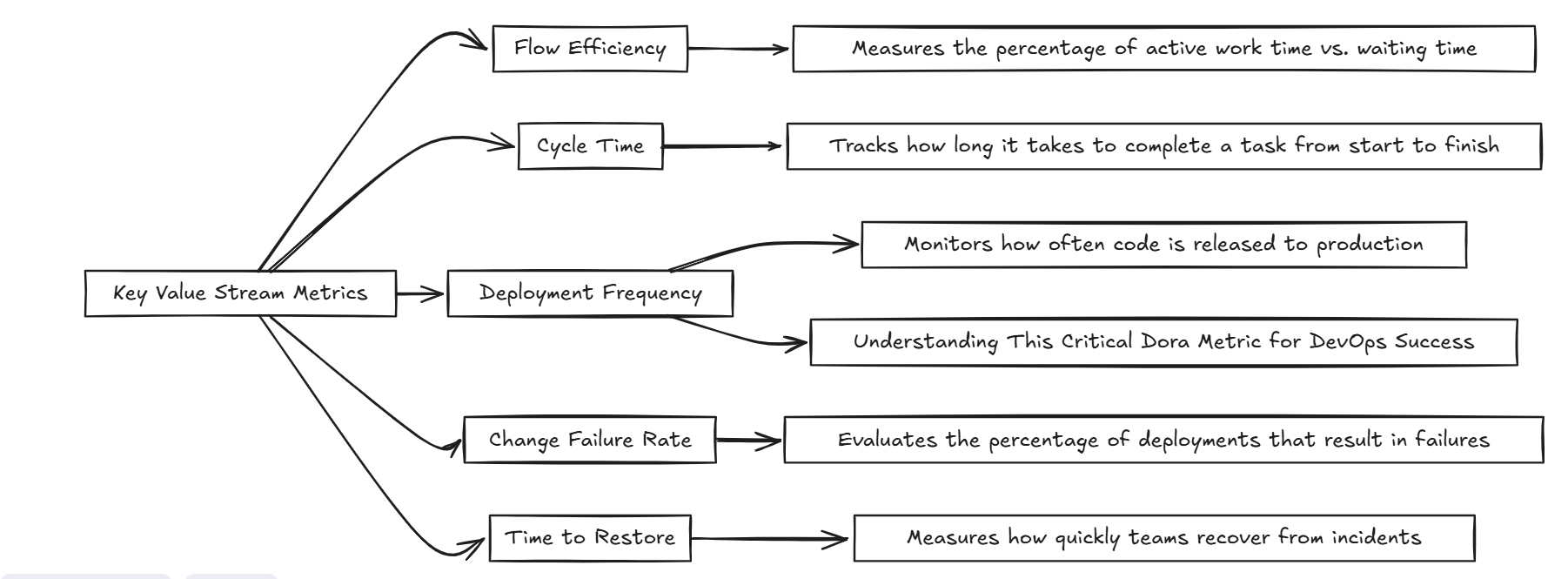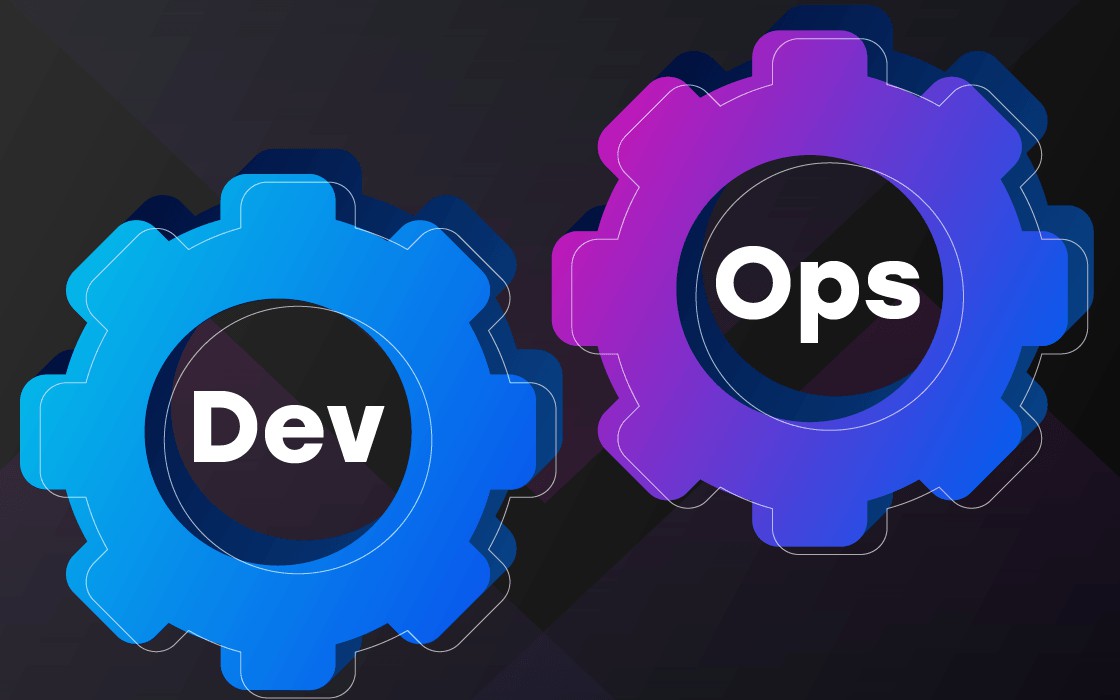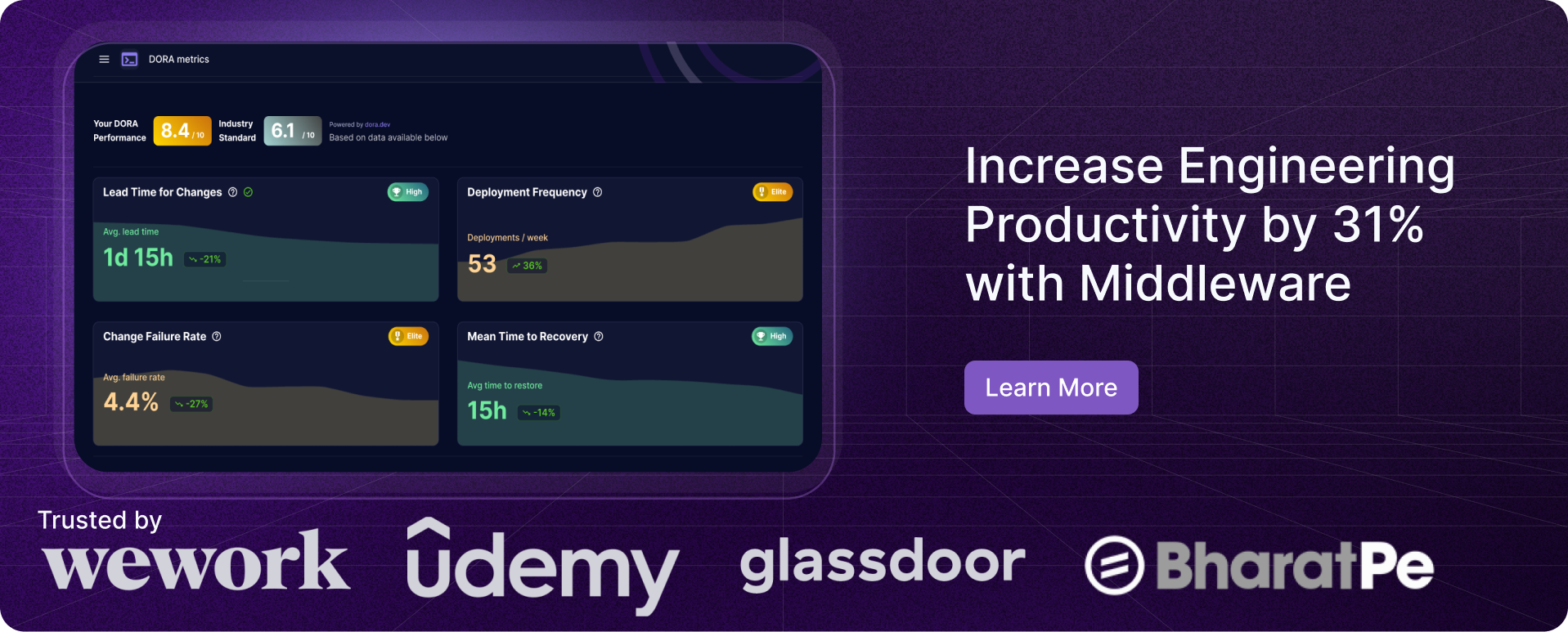Why Your DevOps Pipeline Needs Value Stream Metrics
 Rajni Rethesh
Rajni Rethesh
Introduction
In the software development landscape, speed alone is not enough—efficiency, quality, and customer satisfaction are just as crucial. Value Stream Metrics provide end-to-end visibility into your DevOps pipeline, ensuring that every step in your workflow delivers actual value. If you’re still relying solely on deployment frequency and lead time, you might be missing the bigger picture.
In this blog, we’ll dive deep into why Value Stream Metrics are essential for optimizing your DevOps pipeline, reducing waste, and accelerating business outcomes.
Also read: How to Use Value Stream Mapping (VSM) to Improve Software Delivery
Try Middleware, a powerful platform that helps you track Flow Efficiency, Cycle Time, Deployment Frequency, and more in real time. With actionable insights and automated reporting, Middleware simplifies DevOps monitoring and optimization. Get started today!
What Are Value Stream Metrics in DevOps?
Value Stream Metrics focus on measuring how efficiently value flows from idea to production. Unlike traditional DevOps KPIs, which track performance in silos, these metrics assess the entire software delivery process—from planning and coding to deployment and customer feedback.
Key Value Stream Metrics include:

Flow Efficiency – Measures the percentage of active work time vs. waiting time.
Cycle Time – Tracks how long it takes to complete a task from start to finish.
Deployment Frequency – Monitors how often code is released to production. What Is Deployment Frequency? - Understanding This Critical Dora Metric for DevOps Success
Change Failure Rate – Evaluates the percentage of deployments that result in failures.
Time to Restore – Measures how quickly teams recover from incidents.
Also read: What Are Dora Metrics & How They Can Help Your Software Delivery Process
Why Does Your DevOps Pipeline Need Value Stream Metrics?
1. Identifying Bottlenecks in Software Delivery
Without visibility into workflow inefficiencies, teams often struggle with long lead times and unpredictable releases. Value Stream Metrics highlight bottlenecks, such as slow code reviews, waiting times in testing, or inefficient handoffs between teams.
Example: A DevOps team notices a sharp increase in Cycle Time during the testing phase. By digging deeper, they discover excessive manual testing is delaying deployments. The fix? Implementing automated testing to reduce wait times.
2. Aligning DevOps with Business Outcomes

Traditional DevOps metrics, such as MTTR (Mean Time to Restore) or Deployment Frequency, often focus on engineering performance. However, businesses need to measure whether those efforts translate into customer satisfaction and revenue growth.
Value Stream Metrics connect DevOps efforts with tangible business outcomes, helping teams prioritize work that truly delivers value.
Example: If customers frequently abandon a sign-up flow due to slow response times, tracking Flow Efficiency can reveal that database queries are causing delays, prompting a fix that directly improves user experience.
3. Reducing Waste and Improving Efficiency
Many organizations waste time on non-value-adding activities such as excessive approvals, unnecessary meetings, or waiting for resources. Flow Efficiency Metrics expose these inefficiencies so teams can eliminate unnecessary steps and optimize their processes.
Example: If a team’s Flow Efficiency is below 50%, it means half the time is spent waiting rather than delivering features. By analyzing dependencies and automation gaps, teams can take corrective action.
4. Enabling Continuous Improvement
DevOps isn’t just about faster deployments; it’s about continuous learning and improvement. Value Stream Metrics provide a data-driven way to track progress, set realistic goals, and iterate on processes.
Example: A team tracking Change Failure Rate sees an increase in post-deployment issues. Analyzing the root cause reveals that skipping automated testing during urgent releases is introducing defects. The solution? Strengthening quality checks in CI/CD.
5. Breaking Down Silos Between Teams

One of the biggest challenges in DevOps is team silos, where developers, testers, and operations work in isolation. Value Stream Metrics foster a culture of collaboration by providing a single source of truth for all teams.
Example: Instead of developers blaming testers for slow feedback, a Cycle Time dashboard shows that backlog grooming delays are causing work pile-ups before testing even begins. This insight encourages cross-functional problem-solving rather than finger-pointing.
How to Implement Value Stream Metrics in Your DevOps Pipeline?

1. Map Your Value Stream
Identify all the steps from ideation to delivery and visualize how work moves through your pipeline. Tools like Value Stream Mapping (VSM) can help.
2. Choose the Right Metrics
Focus on metrics that align with your business goals. Avoid vanity metrics that don’t drive actionable improvements.
3. Automate Data Collection
Use DevOps tools like Jenkins, GitLab, Kubernetes, and monitoring solutions (e.g., Datadog, New Relic) to automatically track Flow Efficiency, Cycle Time, and Deployment Frequency.
4. Establish a Feedback Loop
Continuously review Value Stream Metrics in retrospectives and adjust workflows accordingly. Encourage a culture of continuous improvement.
Conclusion
Traditional DevOps metrics only scratch the surface of software delivery performance. Value Stream Metrics provide a holistic view of efficiency, quality, and business impact, enabling teams to eliminate waste, streamline processes, and drive customer-centric innovation.
If you want better visibility into your DevOps pipeline, start leveraging Value Stream Metrics today!
Want to Optimize Your DevOps Metrics?
Try Middleware, a powerful platform that helps you track Flow Efficiency, Cycle Time, Deployment Frequency, and more in real time. With actionable insights and automated reporting, Middleware simplifies DevOps monitoring and optimization. Get started today!
FAQs
1. Why is the concept of a value stream so essential to DevOps?
Value streams provide end-to-end visibility into software delivery, helping teams identify inefficiencies, reduce waste, and accelerate value delivery to customers.
2. What is the key purpose of value stream analysis?
Value stream analysis helps map workflows, identify bottlenecks, and optimize processes to improve efficiency and reduce delays in software development.
3. What are the 4 KPIs of DevOps?
The four key DevOps KPIs (DORA Metrics) are Deployment Frequency, Lead Time for Changes, Change Failure Rate, and Mean Time to Restore (MTTR)—all essential for measuring software delivery performance.
4. Why are value streams important?
Value streams align DevOps efforts with business goals, ensuring that teams focus on delivering meaningful outcomes rather than just completing tasks.
Subscribe to my newsletter
Read articles from Rajni Rethesh directly inside your inbox. Subscribe to the newsletter, and don't miss out.
Written by

Rajni Rethesh
Rajni Rethesh
I'm a senior technical content writer with a knack for writing just about anything, but right now, I'm all about technical writing. I've been cranking out IT articles for the past decade, so I know my stuff. When I'm not geeking out over tech, you can catch me turning everyday folks into fictional characters or getting lost in a good book in my little fantasy bubble.


